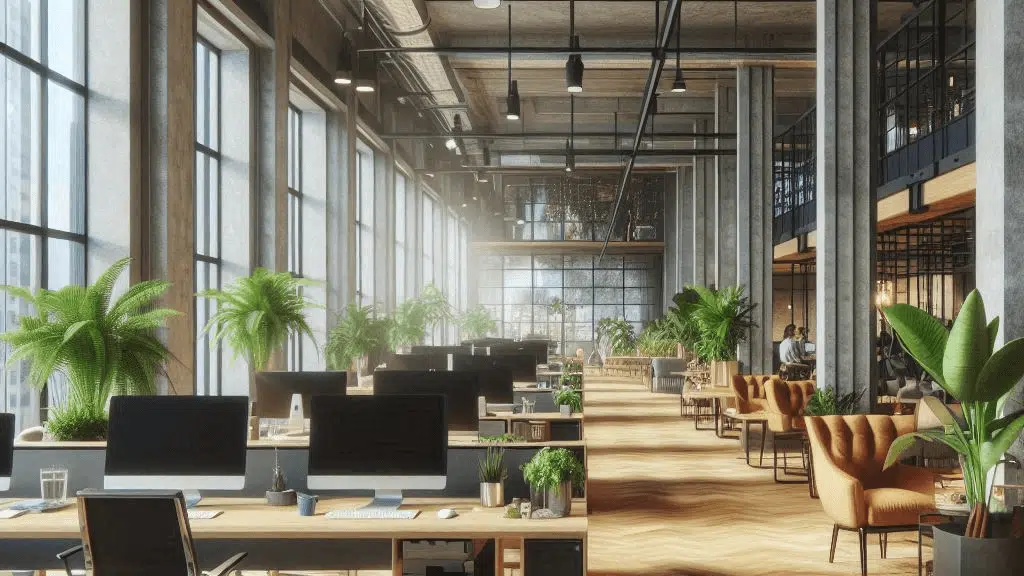When we’re at work, we may not get much say in the environment we work within. In an office, it may feel as though the backdrop to your working environment makes little difference to an employee’s mood or productivity, but that may not necessarily be the case according to experts.
According to MFHA data from 2023, poor mental health accounts for 51% of work-related illnesses including stress, depression and anxiety. To protect employee wellbeing and promote a positive work culture, it is in employers’ interests to do what they can to support good mental health at work. As a business, we support offices with storing office furniture during a relocation and document storage and wanted to find out how the office itself can impact mental wellness, so spoke to Health Psychologist Dr. Ravi Gill, from Smart Mind Health, to find out.
Dr Gill shared the following advice on workplace environment:
“Creating an ideal office environment for positive well-being involves a combination of thoughtful design, layout, lighting and decor that fosters comfort, productivity, and mental well-being. Here are some tips to help design a good working environment:
1. Lighting
One of the most important factors is lighting; you can maximise natural light exposure by positioning workstations near windows. Natural light has been shown to improve mood, energy levels, and productivity. Use warm, indirect lighting for general illumination. Avoid harsh fluorescent lights, which can cause eye strain and stress.

2. Layout
Balance open workspaces with private areas. Open layouts encourage collaboration and communication, while private areas offer quiet zones for focused work and meetings. If it’s possible, try and incorporate adjustable desks (sit-stand) and modular furniture to allow employees to customise their workspaces. This flexibility supports different working styles and can reduce physical strain.
With so many of now hybrid working it’s even more important to create a sense of belonging at work. Create informal breakout spaces with comfortable seating for relaxation, casual meetings, or creative brainstorming sessions. This can be done by
Integrating natural elements like plants, water features, and natural materials (wood, stone) into the office design. Biophilic design helps reduce stress and increases a sense of well-being. Think therapy room but workstation. Invest in ergonomic chairs, adjustable desks, and monitor stands to support good posture and reduce the risk of musculoskeletal problems.
3. Decor
Use a calming colour palette, such as soft blues, greens, and neutrals, to create a serene atmosphere. Brighter colours like yellow and orange can be used sparingly in common areas to energise and inspire. Incorporate artwork that reflects positivity, creativity, and diversity. Wall murals or inspirational quotes can also add character and motivation to the space; company values etc. Encourage employees to personalise their workspaces with photos, plants, or other meaningful items, fostering a sense of ownership and comfort.
4. Acoustics
Use sound-absorbing materials like carpets, curtains, and acoustic panels to minimise noise pollution, which can be a significant source of stress. Consider white noise machines or soft background music in communal areas to mask disruptive sounds and create a more pleasant auditory environment.
5. Wellbeing Spaces
Designate rooms for relaxation, or quiet work, providing employees with a space to decompress and recharge. Offer easy access to water, healthy snacks and fresh fruit to promote healthy eating habits and hydration. If possible, include on-site fitness facilities, or create spaces for stretching, yoga, or even a small gym to encourage physical activity during the day.
6. Good Air Quality
Ensure good air circulation with proper ventilation systems to maintain fresh air and reduce pollutants. Think about different weather conditions and have appropriate things for hot weather such as air conditioning and for colder months i.e. heating systems to ensure comfort. Using air-purifying plants to improve air quality and add also a touch of nature to the office.
What Furniture to Invest in for your Office
Ergonomic furniture
- Adjustable chairs: ergonomic chairs with lumbar support, adjustable height, and armrests reduce strain on the back and neck, promoting physical comfort and mental focus.
- Sit-stand desks: allowing employees to alternate between sitting and standing can reduce fatigue, improve posture and enhance energy levels.
- Keyboard and monitor placement: adjustable monitor stands and keyboard trays help maintain proper posture, reducing eye strain and neck tension.
Office decor
- Indoor plants: adding greenery helps reduce stress, increase productivity, and improve air quality. Plants like peace lilies, snake plants and succulents are low-maintenance and thrive indoors
- Natural light: maximising natural light exposure by using transparent or light-coloured window treatments, mirrors or skylights can boost mood and energy levels
- Nature-inspired decor: incorporating natural elements like wood, stone or water features can create a calming, restorative atmosphere
Paint colours
- Blues, greens and neutrals can create a calming environment, reducing stress and anxiety. Using brighter colours like yellow or orange on an accent wall can add energy and creativity to the space without overwhelming it
How does office design affect mental wellness and productivity?
“Certain office design elements and practices can have a detrimental impact on mental health such as: poor lighting, particularly the absence of natural light, can lead to eye strain, headaches, and disruptions in circadian rhythms, contributing to fatigue, depression and reduced productivity.
“Open plan offices often suffer from high noise levels due to constant chatter, phone calls and general activity. This environment can cause stress, reduce concentration and increase anxiety. Without designated quiet zones or soundproofing, employees may find it nearly impossible to focus or feel at ease, leading to burnout.
“Open plan layouts can also deprive employees of privacy, leading to feelings of vulnerability and discomfort. The inability to have private conversations or personal space can increase stress and anxiety. In workplaces where employees are constantly monitored or have no access to private areas, the lack of privacy can severely affect mental health and contribute towards decreased job satisfaction.
“On the flip side, excessively closed and isolated office spaces can foster feelings of loneliness and disconnection. Working in a cubicle farm or isolated offices can reduce opportunities for social interaction and collaboration, leading to a sense of alienation. If employees are confined to small, windowless rooms or isolated from their peers, this isolation can contribute to depression and a lack of motivation.
“Offices with sterile, bland decor and no personalisation options can feel cold and unwelcoming. Such environments can make employees feel like cogs in a machine rather than valued individuals, reducing morale and engagement. A complete ban on personalising workspaces can further alienate employees, stripping them of their identity at work and contributing to a sense of detachment.
“Poor ventilation and air quality can lead to physical symptoms like headaches, fatigue, and respiratory issues, which in turn affect mental well-being. Stuffy, polluted air can also exacerbate stress and reduce overall comfort. Without proper ventilation or air purification, employees may experience ‘sick building syndrome’, leading to chronic health problems and heightened stress.
“Failing to provide comfortable, inviting break areas can discourage employees from taking necessary breaks, leading to mental fatigue, burnout, and decreased productivity. If break areas are uninviting, overcrowded, or non-existent, employees may skip breaks altogether, leading to increased stress and a decline in mental health. Some may choose to stay within their offices which can be quite isolating.
“Slow or unreliable systems can also affect workload and stress. Outdated or malfunctioning technology can cause delays, frustration and decreased productivity.
The importance of good company culture
“A high-pressure environment with unrealistic expectations can lead to burnout, reducing productivity over time. Poor communication, lack of recognition, or insufficient support from management can decrease motivation and engagement, negatively impacting productivity. Creating a balanced office environment that supports comfort, focus, and well-being is key to maintaining high productivity levels.
If you need self storage Tamworth, Hinckley or Nuneaton we provide state-of-the-art facilities for home storage and business storage. We make storage as simple, easy and hassle free as possible. You can click here to find out more or go online and get a quote in 30 seconds!

